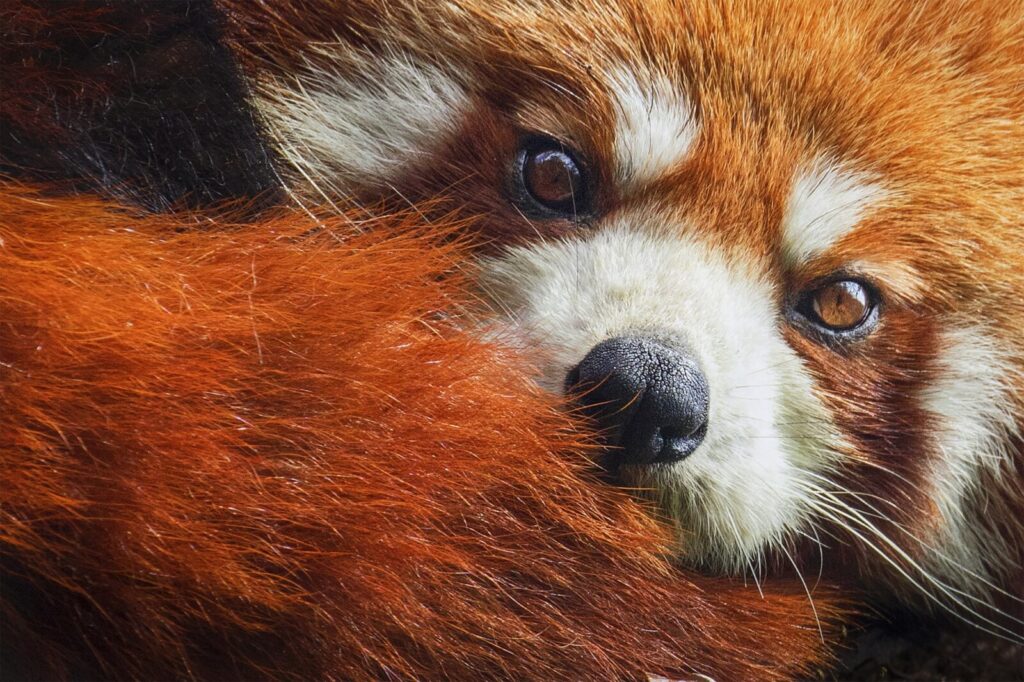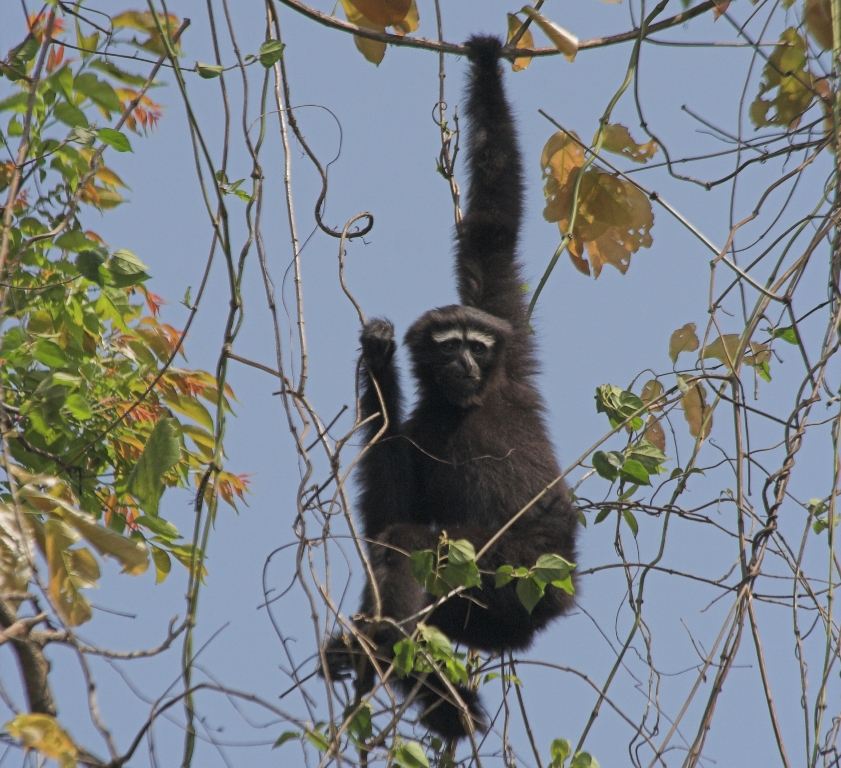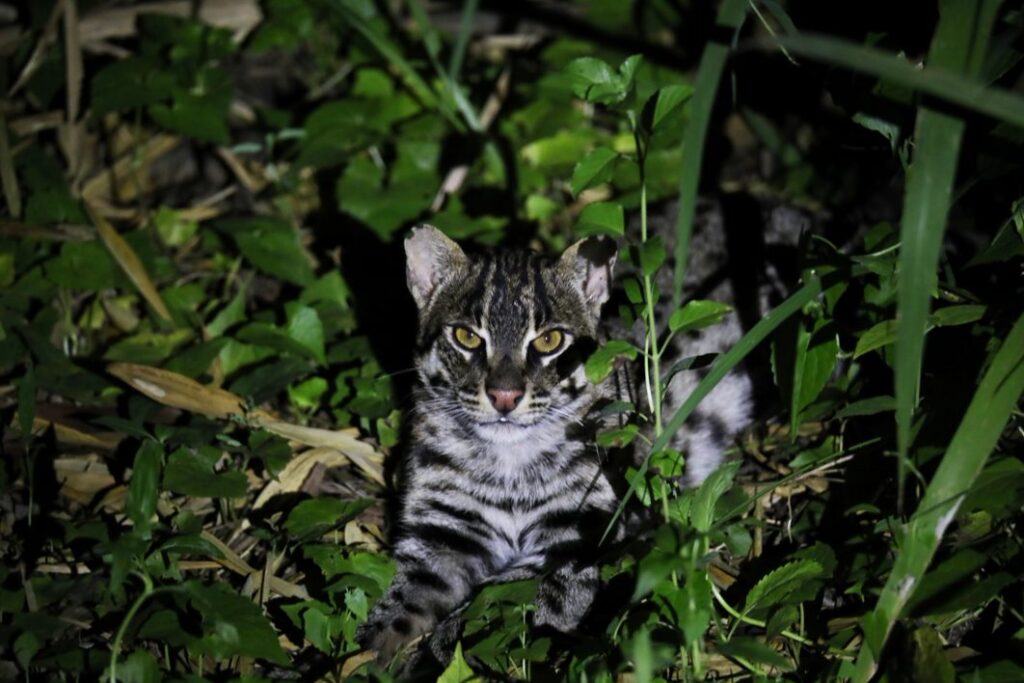India wildlife holidays: 5 amazing animals you did not expect to see
Published on: June 1, 2025 | Last Updated: June 1, 2025
When people think of an Indian wildlife holiday one of the first images that comes to mind is a striped cat emerging from the jungle, then crossing in front of their vehicle before vanishing into the grasslands. While there is no doubt that a tiger safari in India remains a huge draw for visitors you are going to be amazed at our list of 5 amazing Indian mammals that can be seen in a country famous for its wildlife diversity, despite the pressures of a huge human population. In this blog we will tell you all about these incredible animals, including where to find them, best time of year to travel and provide you with some illustrated itineraries including amazing wildlife lodges to stay at.

Red Panda tours: the burning flame of the Himalaya’s and cuter than its big brother
At 3000m the air is thin, so your body moves slowly through the dense Himalayan Forest, following in the footsteps of your local guides who are the masters of spotting and observation. At this altitude mornings are cold and sometimes misty which can make spotting these brightly coloured arboreal mammals more challenging than you expect. Suddenly a flash of red is spotted high in the canopy and our group stops to see our very first Red Panda in the wild and we couldn’t be happier.
The terrain is moist and slippy and in order to get the best photos we need to step off the trail a little onto the forested slopes and look for that gap in the branches that will allow us a full view of this impossible cute Asian mammal.
Red Pandas are found in coniferous forests as well as temperate broadleaf and mixed forests. They are secretive and prefer dense bamboo cover with easy access to water sources. Red Pandas are solitary and spend most of their lives up in the trees. They feed on a mixture of bamboo shoots and leaves, as well as some fruits and blossoms. The mating season for Red Pandas mate is early spring, with the females giving birth to as many as four cubs sometime in the summer. The main threats to Red Pandas are poaching and both destruction and fragmentation of their habitat.
Where to see Red Pandas and best time to travel
Red Pandas are divided into two sub-species, Himalayan Red Pandas and Chinese Red Pandas which are thought to have separated around 250,000 years ago due to glacial movements in the Tibetan Plateau. Currently Wildlife Trails only organise our Red Panda tours in India and our focus is the northeast Himalayas close to the Nepal/India border. Because of our expertise in organising India wildlife holidays since 1999 and better accommodation options we base our groups and clients on the Indian side of the border.
For out Red Panda tours we use Kolkata as our main entry point into the country and then fly our clients to Bagdogra before spending one or two days acclimatising near the famous hill station of Darjeeling. Our final destination is a family run charming homestay located close to Singalila National Park where are daily treks for the chance to see Red Pandas will commence from.
Red Panda tours run in a similar way to primate tours in other parts of the world where designated ‘spotters’ or trackers head out early in the morning to locate the animals. This means that when we go out trekking for the Red Pandas it is not just a random activity but based on recent sightings, so we avoid long exhausting days in the field by combining vehicle transfers and short walks to get to where the Red Pandas are feeding or sleeping. We then stay together and keep quiet, so we do not disturb their daily activities thus ensuring a sustainable approach to wildlife viewing.
The best time to see Red Pandas is from October to April before the start of the pre-monsoon rains which makes trekking at this altitude very difficult. We have multiple departures through these months in small groups with a maximum of 6 clients. Each group will have their own expert local naturalist along with several trackers to ensure your chances of seeing Red Pandas multiple times is high.
Check out our 12 day Red Panda Holiday here for a more detailed itinerary and selection of dates.

Hoollongapar gibbon wildlife sanctuary: Did you know India is home to one species of Gibbon?
The first time I visited Kaziranga national park in Assam India in 2002 my focus was seeing One-horned Rhino and Bengal Tigers. I had no idea that located just a 45-minute drive from the east gate of the park was a small but very significant wildlife sanctuary. This was the Hoollongapar gibbon wildlife sanctuary which is one of the last strongholds of India’s only ape. Not only is this regenerated forest home to over a hundred Gibbons, it also provides excellent habitat for Stump-tailed macaque, Northern Pig-tailed macaque, Eastern Assamese macaque, Rhesus macaque, and Capped Langur. It is also a critically important corridor for Asian Elephants who in this part of northeast India must navigate a landscape dominated by private tea estates where they are far from welcome.
Since that first visit in 2002, I have returned to Kaziranga and other wildlife sanctuaries in Assam and West Bengal many times and I always now stay at a simple homestay close to the Gibbon Sanctuary so I can be there for the morning chorus of the Hoolock Gibbons. To hear this amazing sound as you are walking within the thick forests that finishes with a crescendo flourish it to feel alive and happy that this highly endangered species is still holding on in parts of northeast India despite huge habitat loss which means natural corridors for primates to migrate through have been lost.
Northeast India received monsoon rains earlier than the rest of the North so the best time to visit the Gibbon Sanctuary is from October through to April. The trekking in the forest is flat and relatively easy, although we recommend you purchase some leech shops to avoid these ‘friendly’ stickers enjoying a free lunch at your expense.
Wildlife Trails spend a lot of time in Assam and West Bengal where we have many friends and wildlife guides so why not join us on our Primates, Hornbills and Rhino tour of Assam.

Gangetic River Dolphins: Where to see them in India and how endangered are they?
On the same trip to Assam in 2002 we were lucky enough to get permission to drive all the way along the eastern route of Kaziranga national park to the banks of the vast Brahmaputra River; one of the most spiritual rivers in India and the one which empties into the largest delta in the world which is home to the famous swamp tigers of Sundarbans. The eastern vehicle route in Kaziranga is one of the most beautiful for birding, and also a great chance to see Indian Otters, but the holy grail for us was to see the Gangetic Dolphins swimming and maybe feeding in the silty waters of his immense river.
As you arrive there is a parking area just a few metres from the sandy riverbanks and almost immediately we arrived we could make out the unmistakable head and huge serrated beaks of the Gangetic Dolphins. With Dolphins whether in the rivers or oceans you often hope to see and photograph more than they are willing to show you, and this was definitely the case with the Brahmaputra dolphins. You rarely saw more than half a head and the length of their extended beak for more than a second before they disappeared into the muddy waters, but the viewing was still enthralling as there was a group of them collectively fishing and we were the only vehicle by the river in that moment.
Chambal River and the Brahmaputra: the last home for these critically endangered dolphins
One of the biggest problems in India is that rivers have been used for generations to get rid of human waste, both domestic and industrial, and this has had a devastating effect on marine wildlife such as the Gangetic Dolphins. The Chambal River was one of the few exceptions and that is what a small population of the dolphins survived and became a protected sanctuary for both the dolphins and the equally endangered fish-eating crocodile – the Gharial. Despite this protection and great work by local NGO’s and wildlife lodges like Chambal River Lodge, different threats emerged along the length of this beautiful river, including illegal mining and sand extraction on an industrial scale. Until the various state governments take notice of these threats and together protect the entire length of the Chambal River, the number of Gangetic River Dolphins will continue to decline and may go the way of their ‘relatives’ in China and become extinct.

Black Panther tours in India: The thrilling encounter we had with the famous male leopard, Saya, in Nagerhole
Back in 2017 I was leading a tour to India and Sri Lanka looking for tigers in Tadoba and leopards in Wilpattu and Yala when I spoke to a young naturalist at a lodge in Tadoba and he showed me an incredible video of a Black Panther descending from the top of the tree. I was not just struck by the incredible agility of this young leopard but how incredibly black and shiny its coat was. The back story was the black panther had probably arrived from an adjoining national park and was now making a home in Nagerhole national park. The naturalists brother lived close the park and had been a guide there for several years, so we connected and started to form a plan.
Every big cat is different in terms of its visibility to visitors. Some male tigers are incredibly shy and are only seen once a month, whereas there a tigress who have become so habituated to the tourist vehicles that they happily bring out their young cubs near the roads when they are only 3 months old. Saya at that time fell into the ‘shy male’ category and based on very rough data we found out he was seen 3 or 4 times a month at most and we would need to commit serious safari time to have a chance of a sighting.
So, I returned to India in 2018 leading one of the two groups to visit in April, and after 7 days and 14 separate jeep safaris, both groups had one precious sighting of Saya and returned home very happy. Our sighting was particularly memorable due to the speed of thought and actions of our naturalist Arjun. On an afternoon game drive, we were already pushing the limits of the park exit time when Arjun heard one sole Grey Langur call and immediately told his drive where to head. Although slightly reluctant he eventually agreed, and we arrived just in time to see Saya with his front legs splayed over two baby spotted deer fawns which he had killed. We only had a few seconds to take our photos before he moved from the grassy opening into the dense forest. A first sighting of a black panther that will live with me for the rest of my life.
As our network of wildlife guides in India has grown over the 25 years, we have been travelling here we have seen more and more evidence of melanistic leopards, not all of them as dark black as Saya. One of my friends has a video of a black panther in the hills close to Darjeeling in North India and I also know of a very special location in the tea plantations of Southern India, where a female black panther is regularly photographed with her standard coloured cubs.
Check out our 8 day Black Panther tour to Nagerhole for more information.

Where to see Fishing Cats in India: Why West Bengal is a hotspot for the Asian fishing cat
You know when you visit an Indian national park and they give you that mammal list of the species possible to see there and you flick through the list and get your hopes up for rare species like Caracal, or Leopard cat; when the reality is that park guards who have been going into the sanctuary for 20 years have never seen one, then for sure the chance to see Asian fishing cat falls into that category.
However, during our travels to Northeast India we heard of places not far from the capital Kolkata, where fishing cats were being regularly seen and decided to investigate. The background to this story connects the love of the West Bengalis for their fish and fishing cats taking advantage of this. Such is the huge demand from the city, thousands of fish farms have sprung up in the rural outskirts to supply the cities insatiable appetite. Some are large scale ventures, but many are small ponds, or bunds as they are known locally, with houses built around them, and fish such as carp farmed in them. It is these smaller bunds that are attracting the fishing cats; especially at night then there is less human activity, and they perfect their hunting technique.
Of course, the loss of the fish to the local people is far from ideal but some owners recognized the value of the fishing cats themselves to attract wildlife photographers, who could only ever dream of seeing one inside a national park. They turned their ancestral homes into thriving homestay businesses and following a patient and ethical approach to viewing the fishing cats they created successful ecotourism businesses which brings much needed employment and income into these rural communities.
What ever species of mammal in on your target list, we have the knowledge and local contacts to give you the very best chance of achieving your goal.

